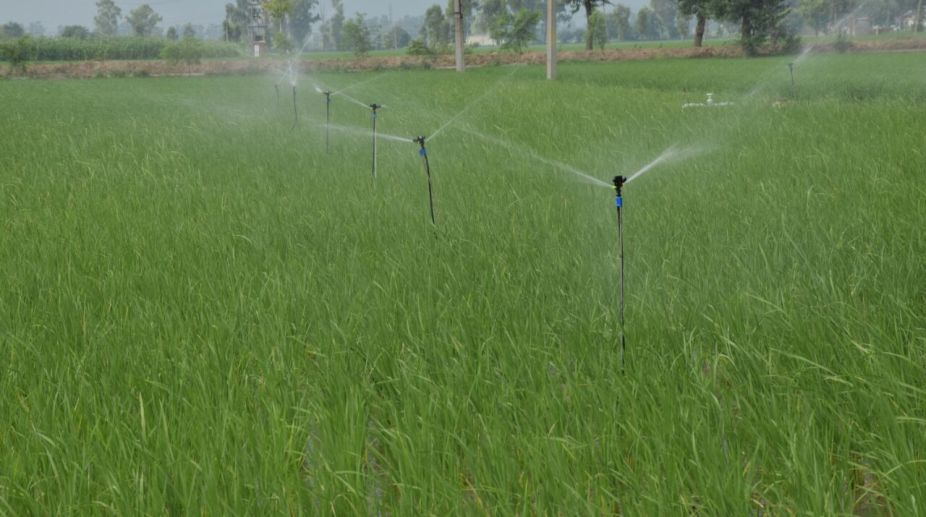‘Walk in the desert, You will realize the cost of Water‘.
Well, the agrarian state Haryana too taking the depleting groundwater seriously, has mulled over a strategy to prevent the over exploitation of groundwater and making its use more sustainable by encouraging farmer to adopt micro-irrigation methods like drip and sprinkle to conserve water and increase production.
Advertisement
The groundwater depletion has emerged as one of the key concerns for Haryana with as the groundwater level in the state has fluctuated more than 50 per cent in the past four decades and one of the main reasons behind the worsening situation is over exploitation of underground water especially in the northern districts where paddy is grown as a major crop.
To tackle the problem, the state government has come out with a multi-pronged strategy under which the efficiency of irrigation water would be enhanced and farmers to be encouraged for adopting micro-irrigation and shifting to less water-intensive crops from traditional crops.
A high level meeting held recently under the chairmanship of Additional Chief Secretary (ACS), Finance Department, P Raghvendra Rao okayed the projects in this regard proposed by the various departments under Irrigation Efficiency Funds to be sponsored by the National Bank for Agriculture and Rural Development (NABARD) for 2017-2018.
This includes Underground Water Conveyance System for efficient Use of Water Distributed through Open Channel, Sprinkler, Drip System and Implementation of Watershed Activities in the state under the Agriculture Department. Micro Irrigation Programme for Horticulture and Agriculture Crops in 36 Over-Exploited and Critical Blocks in Haryana under the Horticulture Department while Water Harvesting and Water Conservation in the said Blocks under the Rural Development Department.
Further, under the scheme are Installation of Solar or Grid Powered Micro Irrigation Infrastructure on Sewage Treatment Plant for Utilising Treated Water for Irrigation, Installation of Community based Solar or Grid Powered Micro Irrigation Infrastructure in Existing Canal Commands in various districts of the state and recycling and reuse of treated water for irrigation in the state under the Irrigation Department. It would be executed by the Canal Area Development Authority (CADA).
A senior official from CADA told The Statesman that country’s first Community Based Solar and Grid Powered Micro Irrigation Infrastructure has been successfully installed at Gumthala Garhu Dera Fateh Singh village of Kurukshetra district and now the Haryana government has proposed to extend this project to one outlet per block with the canal command area.
He said, “Common Micro Irrigation infrastructure will be provided for each canal outlet command for supplying pressurised water supply at the farm gate of each farmer of the outlet instead of constructing lined field channels. Drip or Sprinkler irrigation sets will be installed by the individual farmers in their farm holdings.”
The main objectives of the project are to improve water use efficiency and increase crop productivity. In fact, under the recent experiment carried out by the farmers engaged through the said project in Kurukshetra, it has been found that paddy cultivated through drip irrigation resulted into more production than the paddy cultivated through flood irrigation methods, he added.
Moreover, the CADA has initiated a Pilot Project for utilising surplus water from overflowing ponds in the villages. The farmers of the concerned area to be benefited from this water have been formed Water User Associations to adopt micro-irrigation. At the initial stage, it is proposed to take up this project on a Pilot basis on 50 overflowing ponds in various districts of Haryana.
Working on Sewage Treatment Plants (STPs) for the use of water in the best alternative in enhancing the irrigation, blocks including, Ladwa, Shahabad and Pehowa towns have been selected for the pilot project to be installed for irrigation.
Haryana ACS PK Das who has also participated the said meeting, said that the farmers of the state should be encouraged to adopt a micro-irrigation system, especially the farmers belonging to northern and central districts of Haryana as the availability of sufficient water in these districts does not mean that the flood irrigation methodology should be encouraged amongst the farmers.
According to official information, in 1974 the groundwater was available at 9.19 meter and in 2016 it has gone down to 18.66 meter recording a decline up to 9.47 meter.
Actual situation could be judged by the facts that nearly 71 blocks in 17 districts have been reported over exploited, 15 blocks in 11 districts fall under the critical category while seven as semi-critical.
Most affected districts between 1999-2016 are Mahendragarh recording fluctuation up to -21.38 meter, following by Fatehabad (-19.56), Kaithal (-18.91), Kurukshetra (-18.05), Gurgaon (-13.65), Rewari (-13.90), Karnal (-11.16), Sirsa (-11.03) and Panipat (-10.28).
Experts believe that the situation started becoming pathetic from 1999 with the submersible tube wells getting popular among the farming community in the state.
Official figures show that in 1966 when the state of Haryana came into being, there were merely 27,957 tube wells while in 2014-15 (latest numbers available with the department) the total numbers of tube wells have gone to 87,7151 comprising 3,01,986 diesel tube wells and 5,75,165 electric tube wells recording 30 times increase in the tube wells in the state.
Data shows that paddy production in Haryana has reached to 61.79 metric tonnes (MT) during the year 2015-16 from 36.48 MT in 1998-99.
Approximately 50 per cent agriculture land in Haryana is irrigated through tube wells, 30 per cent, though canal irrigation while 17 per cent is dependent on rainy water.
As Haryana has no single full-time river and underground water in the most of the parts of the state is saline, thus experts believe that micro irrigation is the only answer to this problem.











